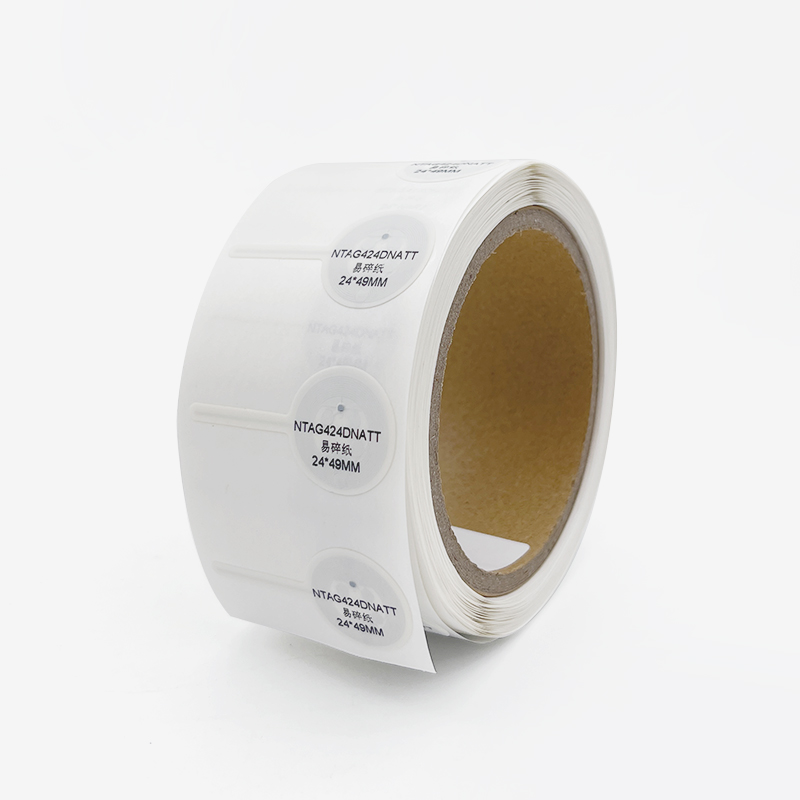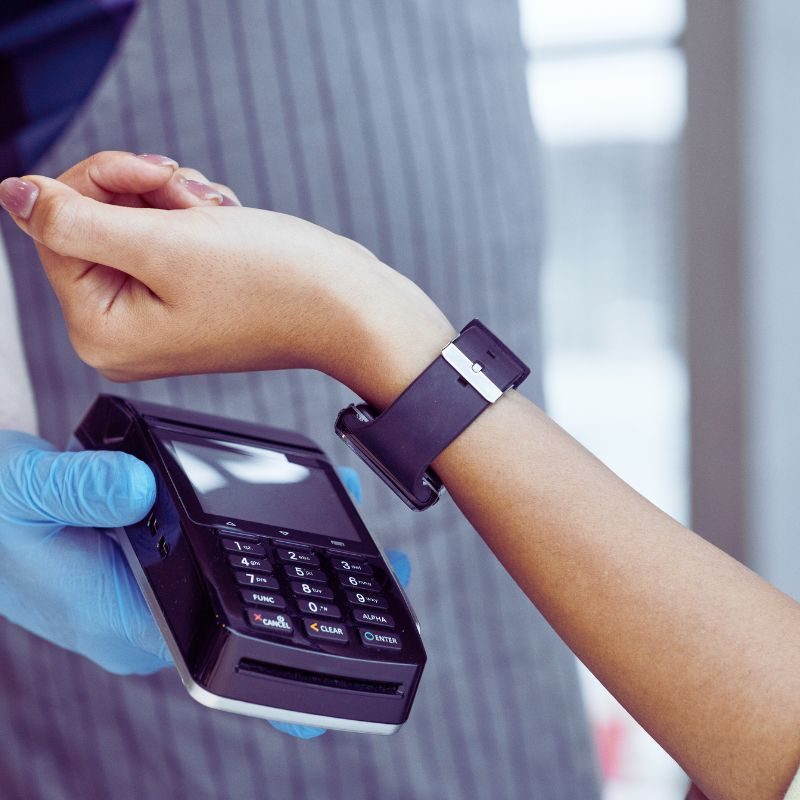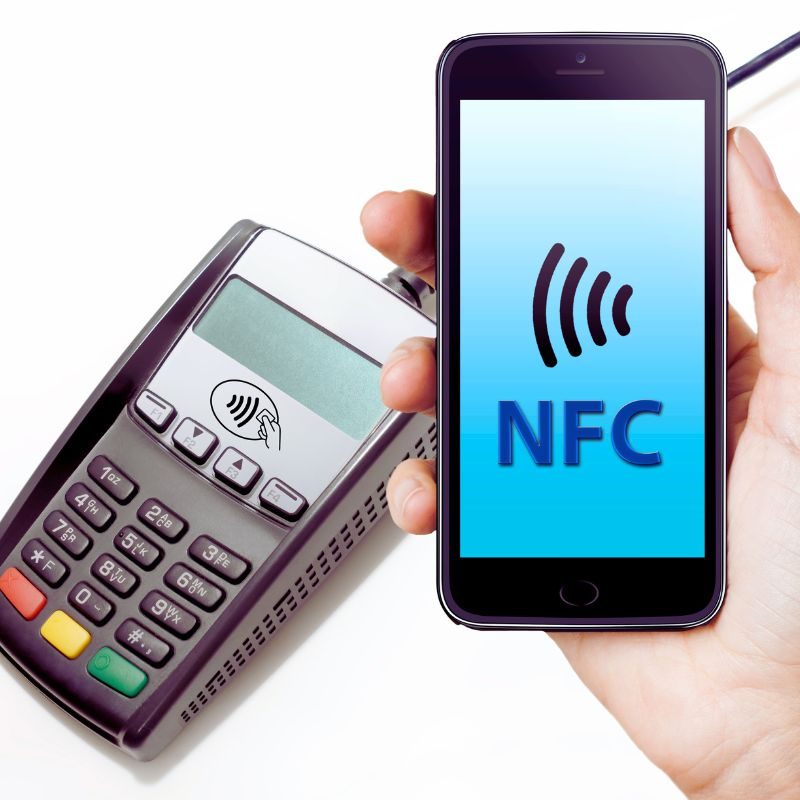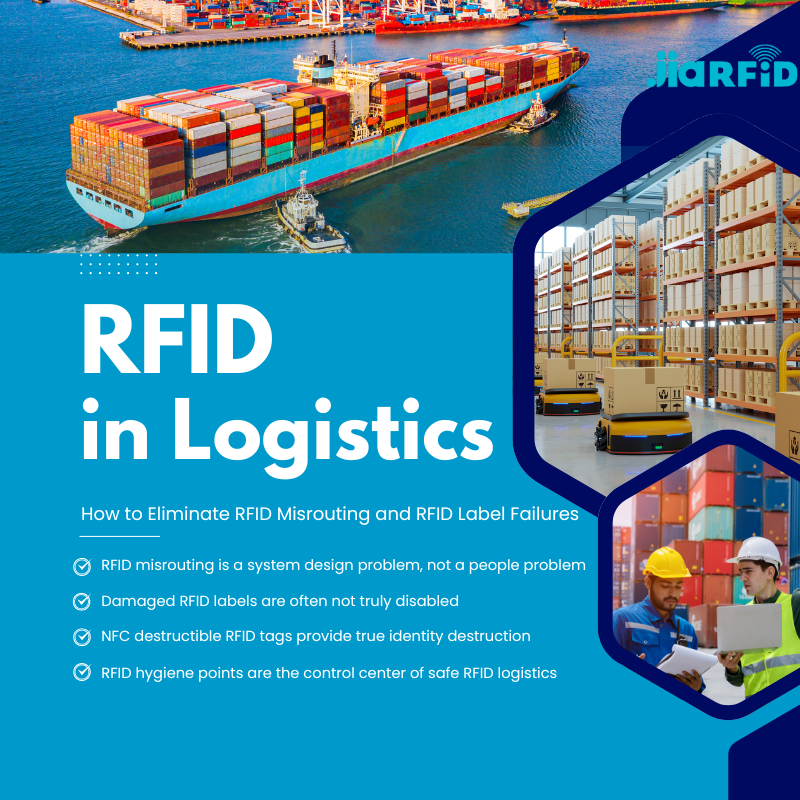
3 Types of RFID: LF HF and UHF
Table of Contents
Decoding RFID: Exploring the Three Main Types of RFID Systems
We will explore how each RFID system works, its strengths and weaknesses, and real-world applications. By the end, you will clearly understand which frequency and type of RFID tag best suits your needs and why taking the time to learn about them is a smart move for any business.

What is a Radio Frequency Identification (RFID) System?
An RFID system uses radio waves to identify and track items. It is similar to a high-tech barcode system but much more powerful. A basic RFID system consists of three components: an RFID tag, an RFID reader, and an antenna. The tag contains a microchip that stores information, and the antenna transmits this data to the reader.
RFID tags can be passive, meaning they do not have their power source and rely on the reader to provide the energy needed to transmit data. They can also be active, meaning they have their power source, like a battery, allowing them to transmit signals over longer distances. RFID technology is transforming industries by providing real-time data and improving efficiency. “RFID is revolutionizing how businesses track assets and manage inventory,” notes industry expert Sarah Johnson. You are in the right place if you are looking for a tailored RFID solution.
What are Passive RFID Systems?
Passive RFID systems use tags that do not have a built-in power source. Instead, these tags draw power from the radio waves emitted by the RFID reader. When a passive RFID tag comes within the read range of a reader, its electromagnetic field powers up the tag, allowing it to send data back to the reader. These are the most common types of RFID tags in use today.
Passive RFID tags are typically cheaper and smaller than active RFID tags because they lack a battery. They are like tiny, silent workers that only speak when spoken to. This makes them ideal for applications where cost and size are important factors, such as tracking retail items or library books. However, their read range is shorter than active RFID tags, requiring a relatively strong signal from the reader to function. If you want to explore passive RFID tags, check out our RFID Inlays.
What are Active RFID Systems?
Active RFID systems use tags with their power source, usually a battery. This allows active RFID tags to transmit signals longer distances than passive RFID tags. Imagine them as having a built-in megaphone to shout their information across a large warehouse. Active tags can also store more data and have additional features, such as sensors to monitor temperature or humidity.
Because of their longer read range and enhanced capabilities, active RFID systems are often used for tracking high-value assets, such as shipping containers, vehicles, or heavy machinery. They are like the sentinels of the RFID world, always on and watching. However, active RFID tags are more expensive than passive RFID tags and require periodic battery replacement. “Active RFID provides unparalleled visibility for high-value asset tracking,” says logistics expert John Miller.
Deep Dive into Low Frequency (LF) RFID Systems
Low Frequency (LF) RFID systems operate within the frequency range of 30 kHz to 300 kHz. They offer a short read range, typically a few centimeters to a few inches. Think of it as a close-talker, needing to be very near to be heard. LF RFID is known for its ability to work well through metal and liquid, making it suitable for challenging environments.
These systems are used for animal identification, access control, and industrial automation. For instance, many pet owners use LF RFID microchips to track their furry friends. LF RFID is also used in car key immobilizers, providing an added layer of security. Its ability to penetrate materials makes it a reliable choice where other frequencies might struggle. Explore our LF RFID Tags for more details.
Exploring High Frequency (HF) RFID Systems
High Frequency (HF) RFID systems operate at 13.56 MHz and provide a read range of a few inches up to about a meter. They offer faster data transfer rates than LF RFID systems. It is like a middle ground, offering more range and speed. HF RFID is commonly used in libraries for book tracking, ticketing systems, and secure access control.
One of the most well-known applications of HF RFID is in contactless smart cards and NFC (Near Field Communication) devices. These systems are used for mobile payments, secure building access, and public transportation. HF RFID’s ability to perform well near liquids and its moderate sensitivity to metals make it a versatile choice for various applications. Learn more about our HF RFID Tags.
Understanding Ultra-High Frequency (UHF) RFID Systems
Although slight regional variations exist, ultra-high frequency (UHF) RFID systems operate globally from 860 MHz to 960 MHz. These systems offer the longest read range among the three types of RFID systems. Passive UHF systems can achieve a read range of up to 12 meters, while active UHF systems can reach 100 meters or more. UHF RFID provides the fastest data transfer rates, making it ideal for applications requiring quick scanning of multiple items. It is like the speedster of the RFID world, scanning many tags quickly and from a distance.
UHF RFID is widely used in retail for inventory management, logistics tracking shipments, and asset management monitoring high-value equipment. The UHF Gen2 standard (ISO/IEC 18000-63) is a widely adopted global protocol for UHF RFID, ensuring interoperability between RFID tags and readers. RAIN RFID, a type of UHF RFID, is gaining popularity for its ability to connect billions of items to the internet, enabling real-time visibility across the supply chain. Our UHF RFID Tags are perfect for these applications.

How Do RFID Frequencies Affect Performance?
The frequency at which an RFID system operates significantly impacts its performance characteristics, including read range, data transfer rate, and ability to penetrate materials. With its lower frequency, LF RFID excels at penetrating metal and liquid but has a short read range. It is the workhorse, tough but limited in reach. HF RFID strikes a balance, offering moderate read range and data speed, with some ability to work near liquids. It is the versatile middle child. UHF RFID, with its higher frequencies, provides the longest read range and fastest data transfer but is more susceptible to interference from metal and liquid. It is the speed demon and is great for scanning many items, but it needs a clear path.
Choosing the right frequency depends on the specific application. LF RFID might be the best choice for tracking metal items or assets in liquid-rich environments. HF RFID suits applications requiring moderate read range and data speed, such as library book tracking or secure access control. UHF RFID is ideal for inventory management, logistics, and asset tracking, where long read range and fast data transfer are crucial.
What are the Different Types of RFID Tags?
RFID tags come in various forms, each designed for specific applications. Broadly, they fall into two main categories: active and passive. Active RFID tags have their power source, allowing them to transmit signals over long distances. They are like having a personal broadcaster for each tag. Passive RFID tags rely on the RFID reader for power and have a shorter read range. They are more like whispers, only heard when someone is listening closely.
Within these categories, there are further classifications based on frequency:
LF RFID Tags: Used for animal tracking, access control, and industrial applications. Check out our RFID Wristbands for secure access solutions.
HF RFID Tags: Commonly used in smart cards, library books, and NFC applications.
UHF RFID Tags: Ideal for retail inventory, logistics, and asset tracking.
Each type has its strengths and weaknesses, depending on the intended use. Learn what is the difference between LF and HF.
How are RFID Systems Used in Different Industries?
RFID technology has entered numerous industries, revolutionizing processes and improving efficiency. In Retail, UHF RFID manages inventory, tracks products, and prevents theft. Imagine knowing exactly what is on your store shelves in real-time. In Logistics and Supply Chain, RFID tracks goods moving from manufacturers to warehouses to stores, providing real-time visibility and reducing delays. It is like having a GPS tracker for every shipment.
In Healthcare, RFID helps manage medical equipment, track pharmaceuticals, and improve patient safety by administering the right medication at the right time. In Agriculture, LF RFID tracks livestock, monitors animal health, and manages feeding schedules. For Asset Management, RFID provides real-time location and status of valuable assets, preventing loss and optimizing utilization.
What are Real-Time Location Systems (RTLS)?
Real-Time Location Systems (RTLS) use active RFID tags to continuously track assets and people within a defined area. These systems are like having an indoor GPS, showing you exactly where everything is at any given moment. RTLS typically uses active RFID tags that transmit signals at regular intervals, allowing the system to pinpoint their location accurately.
RTLS is used in various industries, including healthcare, to track medical equipment and monitor patient flow, manufacturing to optimize workflows and locate tools and parts, and logistics to manage yard operations and track shipments. By providing real-time visibility, RTLS helps businesses improve efficiency, reduce costs, and enhance safety.
FAQs
What are the three main types of RFID systems?
The three main types of RFID systems are Low Frequency (LF), High Frequency (HF), and Ultra-High Frequency (UHF). Each operates at a different frequency range and offers unique capabilities regarding read range, data transfer rate, and suitability for various applications.
What is the difference between active and passive RFID tags?
Active RFID tags have a power source, usually a battery, which allows them to transmit signals over longer distances and store more data. Passive RFID tags do not have a built-in power source and rely on the RFID reader to provide the energy needed to transmit data. They have a shorter read range but are cheaper and smaller than active tags.
Which type of RFID system is best for inventory management?
UHF RFID systems are generally considered best for inventory management due to their long read range, fast data transfer rates, and ability to read multiple tags simultaneously. This allows for quick and accurate tracking of large numbers of items in retail, warehousing, and logistics.
How does RFID technology improve supply chain visibility?
RFID technology provides real-time data on the location and status of goods as they move through the supply chain. This visibility helps businesses optimize logistics, reduce delays, prevent theft, and improve efficiency.
Can RFID tags be used to track animals?
Yes, LF RFID tags are commonly used to track animals. These tags can be implanted under the skin and provide a reliable way to identify and monitor livestock, pets, and wildlife.
What are the advantages of using RTLS in healthcare?
In healthcare, RTLS can track medical equipment, monitor patient flow, and ensure that critical assets are readily available when needed. This improves efficiency, reduces costs associated with lost or misplaced equipment, and enhances patient care.
Key Takeaways
RFID technology uses radio waves to identify and track items. An RFID system includes a tag, a reader, and an antenna.
There are three main types of RFID systems: Low Frequency (LF), High Frequency (HF), and Ultra-High Frequency (UHF).
Passive RFID tags do not have their power source and rely on the reader for energy, while active RFID tags have a built-in battery.
LF RFID offers a short read range but excels at penetrating metal and liquid.
HF RFID provides a moderate read range and data speed, commonly used in smart cards and NFC.
UHF RFID offers the longest read range and fastest data transfer, which is ideal for inventory management and logistics.
The frequency of an RFID system affects its performance, including read range, data rate, and material penetration.
RFID tags come in various forms, including LF, HF, and UHF, each suited for different applications.
RFID is used across Retail, Logistics, Healthcare, Agriculture, and Asset Management industries.
Real-Time Location Systems (RTLS) use active RFID tags to track assets and people continuously.
By understanding the different types of RFID systems and their capabilities, businesses can make informed decisions to improve efficiency, enhance security, and streamline operations. As a leading provider of custom RFID solutions, we are dedicated to helping you find the perfect RFID technology to meet your unique needs.
Comments
Hot Products

RFID in Logistics: How to Eliminate RFID Misrouting and RFID Label Failures
RFID in logistics is more than just a tool to speed up processes. It has become a key part of how modern supply chains operate.

What Is RFID Waste Management
Imagine a city where every trash bin speaks — not literally — but through a tiny chip that tells the system when it’s full, when it’s emptied, and where it went. That’s what RFID waste management is doing today.

What are Bolt Seals and their Applications? | Complete Guide
In global trade and logistics, bolt seals play a crucial role in ensuring cargo security and compliance. These small but powerful devices are designed to lock shipping containers, trailers, and cargo doors with a tamper-evident mechanism.

What is an RFID Card Protector? Benefits, Use Cases, and Buying Guide
RFID technology (Radio Frequency Identification) is everywhere: in your credit cards, ID badges, transit passes, hotel room keys, and more. It offers speed and convenience, but it also opens the door to a new kind of digital theft called “skimming.” That’s where an RFID card protector comes in.

RFID Wristbands for Events: Bulk Buying Guide for Organizers
RFID wristbands for events are becoming the go-to solution for organizers who need faster entry, fraud prevention, and cashless payments at concerts, festivals, and sports venues. Unlike paper tickets or QR codes, these smart wristbands use embedded chips to streamline access, secure transactions, and improve the guest experience.

How RFID Tag on Windscreen Improves Vehicle Access Control and Toll Systems
In today’s fast-paced world, vehicle identification needs to be quick, secure, and contactless. An RFID Tag on the Windscreen provides exactly that — a reliable way to manage toll collection, parking, and gated access without stopping vehicles.
Tags
RELATED BLOGS

RFID in Logistics: How to Eliminate RFID Misrouting and RFID Label Failures
RFID in logistics is more than just a tool to speed up processes. It has become a key part of how modern supply chains operate.

What Is RFID Waste Management
Imagine a city where every trash bin speaks — not literally — but through a tiny chip that tells the system when it’s full, when it’s emptied, and where it went. That’s what RFID waste management is doing today.

What are Bolt Seals and their Applications? | Complete Guide
In global trade and logistics, bolt seals play a crucial role in ensuring cargo security and compliance. These small but powerful devices are designed to lock shipping containers, trailers, and cargo doors with a tamper-evident mechanism.




